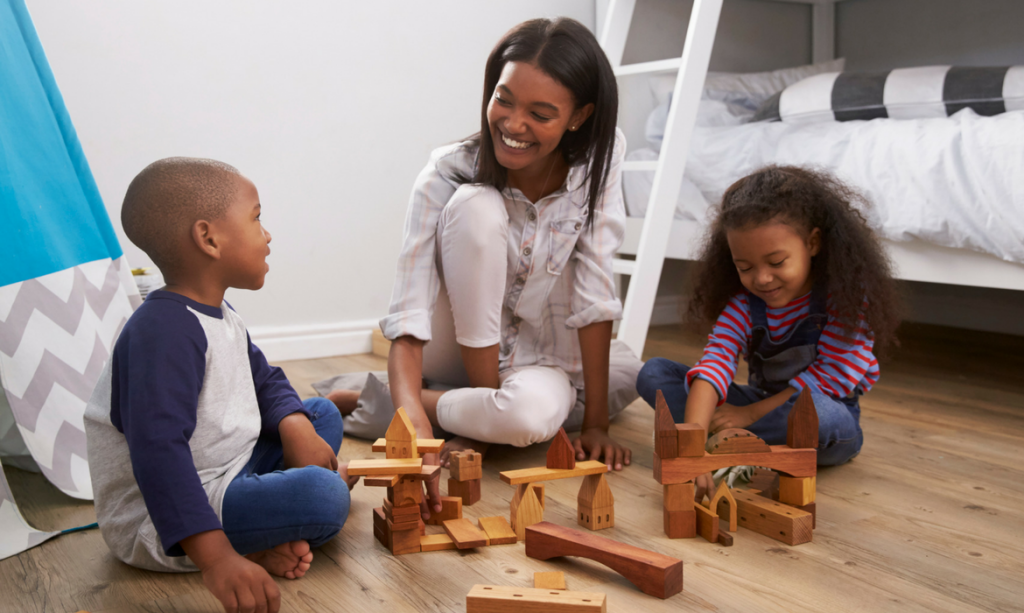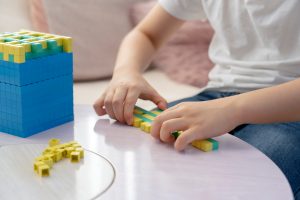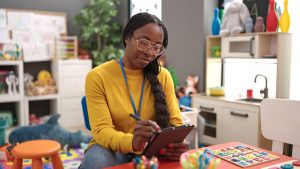When people think about early math skills, they may first think about numbers, such as learning to count and recognizing numerals. However, there is another major component to children’s early math learning that plays a role in children’s later math achievement: spatial reasoning.
Just as parents can support children’s math learning through talking about numbers and their relationships (e.g., “5 is a bigger number than 4”), they can also talk about spatial relationships and shapes to help young children prepare for later math learning.
Here we talk about why spatial reasoning is important and then offer suggestions to help parents recognize the spatial talk they are already using with their children—and how to do more.
What is Spatial Reasoning?
Spatial abilities include being able to think about
- how objects look when rotated (e.g., if you turn a V to the side, where will the opening be)
- how objects look from different angles, (e.g., what a pyramid looks like from the side or if you were looking at it from above)
- how objects look on the inside (e.g., if you slice a cylinder down the middle of the circle on top and open it up you will see a rectangle!)
- how parts of an object fit together, such as being able to imagine that if two triangles are put together a certain way, they would make a rectangle
- how positions of objects relate to each other, such as understanding that a car is inside a garage or a tree is behind a fence.
Why Does Spatial Reasoning Help with Math?

Having strong abilities to mentally picture and manipulate objects in the ways described above predicts success in science, technology, engineering, and math (STEM) fields. [1] Spatial skills may actually help kids think about numbers, too. For example, visualizing spatial transformations may allow children more easily to think of numbers linearly, from smallest to largest, or to solve calculation problems mentally. [2, 3]
Spatial Learning in the Home

Children explore spatial concepts through play from an early age. For instance, building with blocks and playing with puzzles have both been linked to stronger spatial skills. [4, 5]
Additionally, young children who hear more spatial words from their parents tend to talk about space more themselves, and these same children perform better on later spatial reasoning tasks than their peers who hear fewer spatial words. [6] Importantly, parents engage in certain spatial activities, notably block play, more with boys than girls, and parents provide preschool boys with more spatial language than preschool girls, possibly because of such activity differences. [7, 8, 9] By encouraging both boys and girls to play with blocks and puzzles from an early age, and by providing spatial language while they engage in these and other activities, parents can help support children’s spatial thinking.
What is Spatial Talk?

Parents probably already use a lot of spatial words with their children–square, round, big, under. But being more aware of what counts as spatial talk might help parents use spatial words in a way that helps their children learn.
First, what do we mean by spatial talk? Researchers have identified several categories of spatial talk. [6, 10]
- Shape terms: standard math names for two- and three-dimensional objects, such as circle, triangle, rectangle, cone, pyramid
- Dimensional adjectives: words describing size of objects, people, and spaces, such as big, little, long, short, tall, tiny, huge
- Spatial features terms: words describing features and properties of two- and three-dimensional objects, spaces, and people, such as curvy, edge, side, line, corner, straight, flat
- Spatial location and directions: words that describe the relative position of objects, people, and points in space, such as between, into, forward, over, behind, near, far
Tips for Parents on Using Spatial Talk
How can you help children learn from hearing spatial words? Here are some tips for parents to engage in spatial talk. These tips can help promote strong spatial thinking in your child, and most children find spatial talk and spatial play fun and interesting!
When talking about shapes, go beyond labeling the shape. Talk about the defining features.
- “These are both triangles, because all triangles have three sidesand three angles.”
- “While all rectangles have four sides, squares are a special kind of rectangle that have four sides that are all the same length.”
Make the most of spatial activities such as block building and puzzle play by using spatial talk during the activities.
- “Let’s put the big, wide blocks on the bottom, and put the small, narrow blocks on the top.”
- “I know this puzzle piece is a corner piece because it has two flat (or straight) edges.”
Use spatial talk during activities your child loves.
- When your child is on the playground, describe her spatial location as she is on the go. “You went over the bridge, and now you are running under the monkey bars!”
- Talk about space in the illustrations when you are reading books. “That giraffe is really tall and is standing behind a highfence.”
Use gestures such as pointing or tracing objects to help your child understand what the spatial words you are using mean.
- When you say “straight edge” move your finger along the edge to show your child what straight means.
- Encourage your child to use gestures when she is using spatial words.
Ask questions and play games to help your child talk about space and shapes.
- Ask your child to find shapes in the world and identify them. To help her learn to describe shapes, follow up by asking questions such as, “How do you know it’s a triangle?”
- Tell your child that you are thinking of an object in the room and have him ask you questions to guess what it is. Encourage your child to use spatial words to figure out what object you have in mind. “Is it near the chair? Is it wider than the table?”
[1] Wai, J., Lubinski, D., & Benbow, C. P. (2009). Spatial ability for STEM domains: Aligning over 50 years of cumulative psychological knowledge solidifies its importance. Journal of Educational Psychology, 101, 817–835.
[2] Gunderson, E. A., Ramirez, G., Beilock, S. L., & Levine, S. C. (2012). The relation between spatial skill and early number knowledge: The role of the linear number line. Developmental Psychology, 48, 1229–1241.
[3] Cheng, Y. L., & Mix, K. S. (2014). Spatial training improves children’s mathematics ability. Journal of Cognition and Development, 15, 2–11.
[4] Casey, M. B., Andrews, N., Schindler, H., Kersh, J. E., Samper, A., & Copley, J. (2008). The development of spatial skills through interventions involving block building activities. Cognition and Instruction, 26, 269–309.
[5] Levine, S. C., Ratliff, K. R., Huttenlocher, J., & Cannon, D. (2012). Early puzzle play: A predictor of preschoolers’ spatial transformation skill. Developmental Psychology, 48, 530–542.
[6] Pruden, S. M., Levine, S. C., & Huttenlocher, J. (2011). Children’s spatial thinking: Does talk about the spatial world matter? Developmental Science, 14, 1417–1430.
[7] Kersh, J., Casey, B. M., & Young, J. M. (2008). Research on spatial skills and block building in girls and boys. In O. N. Saracho & B. Spodek (Eds.), Contemporary perspectives on mathematics in early childhood education (pp. 233–251). Charlotte, NC: Information Age.
[8] Pruden, S. M., & Levine, S. C. (2017). Parents’ spatial language mediates a sex difference in preschoolers’ spatial-language use. Psychological Science, 28, 1583-1596.
[9] Dearing, E., Casey, B. M., Ganley, C. M., Tillinger, M., Laski, E., & Montecillo, C. (2012). Young girls’ arithmetic and spatial skills: The distal and proximal roles of family socioeconomics and home learning experiences. Early Childhood Research Quarterly, 27, 458–470.
[10] Cannon, J., Levine, S., & Huttenlocher, J. (2007). A system for analyzing children and caregivers’ language about space in structured and unstructured contexts (Spatial Intelligence and Learning Center Technical Report). Retrieved from http://www.silccenter.org/media/silc_pdfs/resources/testsandinstruments/Spatial%20Language%20Coding%20Manual%201-10-12.pdf



